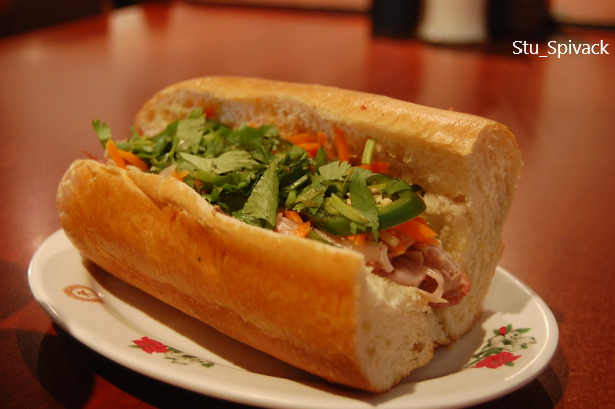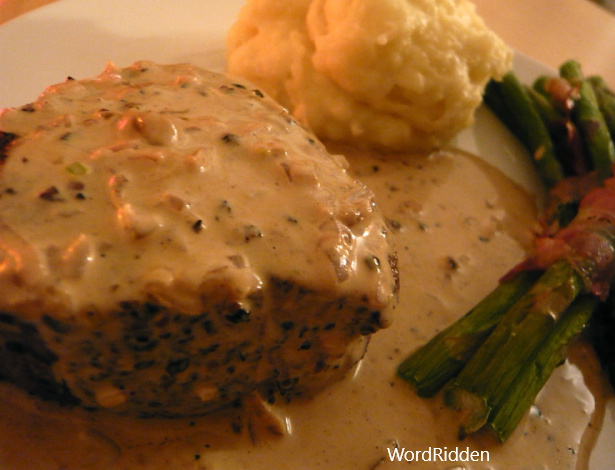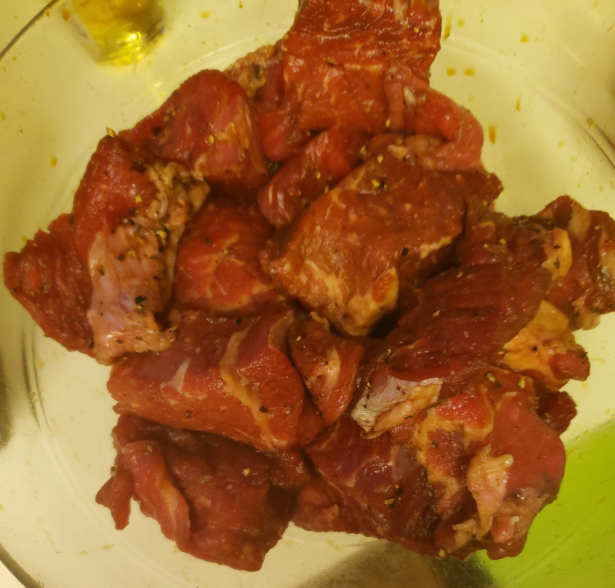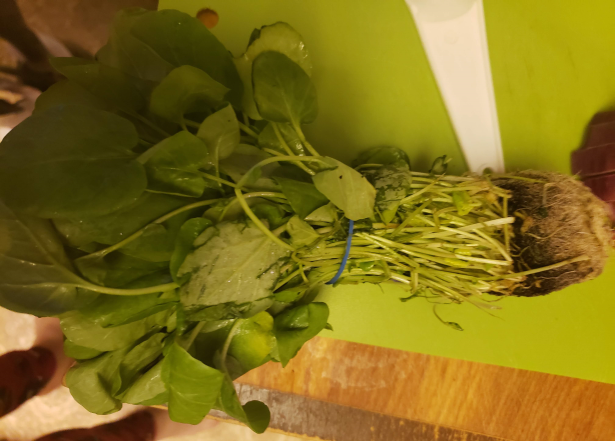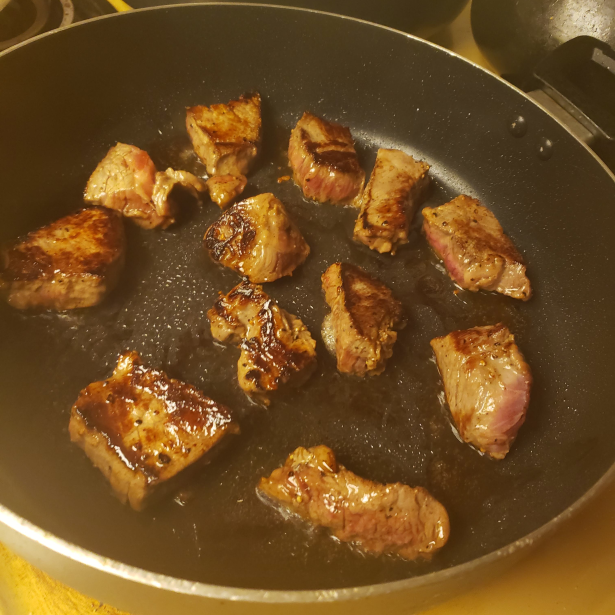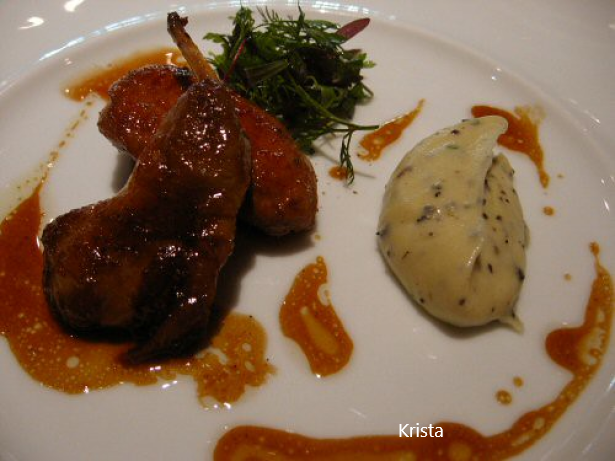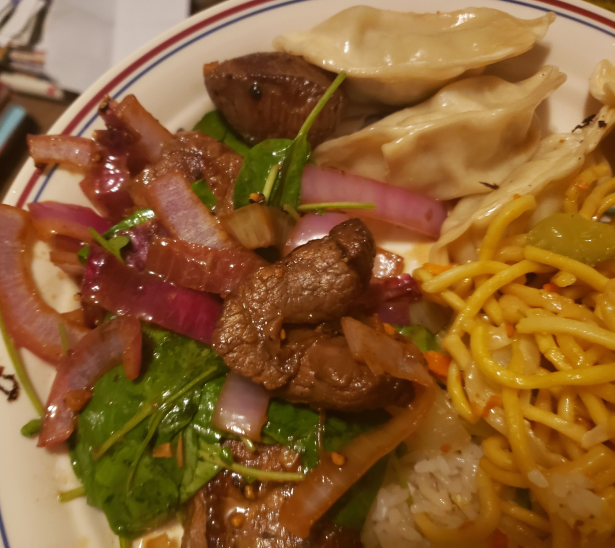KC 190 – Non-Shaking Shaking Beef

Why Hello there, and welcome to Kitchen Catastrophe. I’m your existential Explorer, Jon O’Guin, and today’s recipe, as the title says, takes us into very fraught territory indeed. We are going to make a dish with a signature style so important to its creation that it forms the very basis of its name. And we are going to avoid using that style almost entirely. How do we struggle to define a Shaking Beef Sans Shaking? Well, if you don’t give a crap about that mystery, and just want the meat, click this link to get the recipe. Everyone else, let’s get sleuthing!
Bon Matin, Vietnam
Now, we’ve talked about Vietnam a couple times on the site before, mostly focusing on the culinary legacy of the French colonization of the region and how it has indelibly imprinted itself into the cuisine of Vietnam, with the two most famous dishes of Vietnam, Pho and Banh Mi, BOTH being derived from French ideals and cuisines (Pho being, in essence, a riff on Pot-au-feu, and Banh Mi being a meat and PATE sandwich on baguette).
Those jalapeñoes aren’t native to Vietnam either.
And…that’s really kind of inescapable. It’s one of the facets of modern history we must all reconcile ourselves with: that the flawed decisions of the past shape our present. A LOT of modern day problems can be traced to decisions made 30, 60, 90 years ago, and the unexpected results. And while sometimes the outcomes and influences are obvious (again, see the BAGUETTE SANDWICH example), sometimes, they creep in, un-noticed and invisible.
Today’s dish, for instance: Shaking Beef, or…damn it, I do NOT want to learn diacritical marks for ANOTHER language..ahem: Bò lúc lắc, is a Vietnamese dish that I found DOZENS of references to being “French Inspired”. Except, for all the people willing to repeat that claim, NONE OF THEM could say HOW it was French-inspired. The CLOSEST I could find was an COMMENT on a blog, connecting the idea to “Steak in Black Pepper Sauce”, a CHINESE dish…as another riff on the same French inspiration. Which…I mean, there’s really only ONE French dish I know of Beef and Black Pepper, which is steak au poivre. And If THAT is supposed to be the inspiration for this, then holy CRAP was there a lot lost in translation.
Mostly the milky parts.
To really get at just how DIFFERENT these are, we need to really unpack and explain what, exactly, Shaking Beef is, and how it’s made. So…allons-y!
Shake, Shake, Shake, Señora
Alright, the first thing you gotta understand about Shaking Beef is the name. The name is A: a very simple reference to how the dish is made, and B: A kind-of clever half-pun about the dish.
This is because Bò lúc lắc doesn’t LITERALLY translate in a clean way. Or rather, it DOES, but you need further context to get it. The first word there is literally “Beef”. Meanwhile, “lúc lắc” translates to “Shaking/rolling”. Hence, “Shaking Beef”. BUT, there’s another layer, and it’s because of another word in Vietnamese: hột lúc lắc, which is the term used for “A small figure with flat sides used in games of chance”
“Mostly cube-shaped, but nerds use a bunch of weird shapes”
Yes, “hột lúc lắc” means “Dice”, or “Die”. I’m unsure if it’s the plural or not. And, as we just noted, two thirds of the name mean “Shaking/Rolling”. The FIRST word means something like “Seed” So “Dice” in Vietnamese are “Shaking Seeds”. This is the half-pun: because the initial recipes for Shaking Beef call for the beef to be DICED. As in “cut into dice shapes”. And then you “roll” them while cooking, like dice. It’s a name that works on multiple levels, in such a simple way that it’s honestly pretty dumb. Like, imagine if I gave you recipe for “Ground Turkey” where you mashed it up, and then buried it. In the ground. That’s the kind of verbal complexity we’re working with here.
Now, part of the REASON you ‘shake’ the diced beef is because of a little cultural distinction between cooking implements. Basically, the kind of burners that commercial Asian restaurants use to heat their woks put out a, and this is the scientific term, “Metric fuckton” more heat than a typical western stove. My family’s stove is an electric model, which measures heat in Wattage. Which can be converted into more conventional BTUs fairly easily. For instance, a $1,000 new electrical stove is going to have elements ranging in power from 1200 to 3000 watts, or roughly 4,000 to 10,000 BTUs. Which is good. An average western stove burner puts around 7,000 BTUs, with super-strong burners reaching as high as 12,000. One BTU is enough to heat 1 pound of water 1 degree, or roughly as hot as one match.
That’s a lot of confusing math, so let me make it a little easier, with some more math. If you wanted to boil water, you would just under 1,200 BTUs to bring a gallon of water to a boil in 1 hour. So a 4,000 BTU burner should boil water in about 18 minutes. A 7,000 BTU burner should boil water in a little over 10 minutes. And a 12,000 BTU burner should bring a gallon of water to boil in around 6 minutes. (NOTE: This is mathematically correct, but physically wrong, since burners don’t perfectly convey heat to pots, and pots don’t perfectly convert heat to water, so technically these will ALL take longer, which is why if you have a “super-boil” burner, it probably says it’ll take about 10 minutes: it’s a 12k burner, but it can only do so much.)
As the old Physics joke goes, “First, assume a spherical cow.”
Got all that? A normal stove burner is about 7,000 BTUs, and a super-strong one is 12,000.
Good.
A commercial grade wok burner rangers from 20,000 BTUs on the weak end, with 50,000-100,000 as a “normal” burner, up to over 200,000 on the high end.
This is a standard commercial grade Wok burner. 95,000 BTUs for $450.
Is that a bargain? I don’t know.
So, at high temp, an Asian restaurant burner is putting out almost 30 TIMES more heat than the standard stove burner, and the average one is like, 7.5 times hotter! Hence why this dish is “Shaken” like Dice: anything more than a couple SECONDS of sitting on the wok surface and it’ll over-cook!
And THAT makes things…weird. And my explanation was about to get weird. Look, the easiest way to explain this is to, well, EXPLAIN it. So before I point out what’s going on, I have to tell you how to make Shaking Beef.
Not Shaken, Nor Stirred
So, first off, this recipe comes from Milk Street, though it shares a LOT of DNA with a lot of other recipes. What Milk Street does that makes it interesting is take the above points, and invert the logic of them: The sear on the outside of Shaking Beef is so good because it only touches the insanely hot wok for a matter of seconds. So, if our cooking element is 7.5 times weaker…just let the meat sit for 7.5 times LONGER. Thus, the secret to “No-Shaking Shaking Beef”: Once you drop your meat in the pan, you don’t touch it for 90 seconds, to allow it to sear.
Turns out, it’s hard to represent “Do nothing for a minute” in photographic mode.
However, I’ve gotten ahead of myself. Because this, as it turns out is a recipe that requires some prep. A little, as the French would call it mise-en-place. AS this is, functionally, a stir-fry, we’re dealing with multiple steps whose cooking time is measurable in seconds., thus it behooves us to prepare our meat, veg, and sauce ahead of heating a pan, in order to be read. The first step is to briefly marinade the beef. Cut it into chunks of about one and a half inches, and toss in a marinade of soy sauce and ground black pepper.
Seen here, with the soy sauce completely absorbed.
Also, these chunks are bigger than in the original because you’re letting them sit so long.
Let that sit while you tackle the other ingredients that need chopping, which are…only 3 things? Holy crap, that’s amazing. I know you’ve heard this before, but I am BAD at mise-en-place, and I hate pre-chopping things. (I think it’s because the counters in my house were built for someone a little shorter than me, so they’re like, 1-2” outside my comfortable reach. So whenever I cut for more than like, 6 minutes, I get a bit of pain in my back, as I have to stretch my back to reach the counter. And Stir fries often mean I have to chop a BUNCH of crap. So slicing ONE onion, chopping some garlic, and cutting the stems off of some watercress is a pretty easy ask for me.
My favorite kind of cutting is when it’s one cut through a bunch of stems.
Then, you gotta make the sauce. Which has a fair amount of what I tend to think of when I think of “Vietnamese savory dishes”: soy sauce, garlic, fish sauce, and sugar. There are other flavors important to Vietnam (as we’ll touch on later), but that’s a pretty solid basis for a lot of their recipes. A sort of punch in the mouth of bold flavors.
And once you’ve got everything prepped, it’s time to start cooking. Get an oiled pan up to medium-high heat, and drop the beef in. Let it sit for 90 seconds to get that nice browning and crust, and then, using tongs, flip each piece.
Flipped and crispy
Another 90 seconds SHOULD cook your beef through, but as I’ve mentioned several times, my family’s stove is quite old. It was made EITHER in the 70’s or 80’s, and I can’t narrow it down more than that at the moment because Whirlpool refuses to acknowledge (at least digitally), that they even MADE this oven, let alone WHEN they did it. As such, it struggles to output heat correctly. So I definitely had to add an extra flip and maybe another 30-45 seconds to get everything looking right.
Once it IS looking right, pull it out, and toss it in a bowl. Then, you’re going to start the sauce: lower the heat to medium, and toss in the garlic, cooking for under a minute, just to get the oils in the garlic active, and then add the rest of the sauce. Put the heat back up to medium high, pour in any drippings that have accumulated in the beef bowl and reduce down the sauce. I personally believe that this is where I messed up my recipe (in as much as I did mess it up), as I think I under-reduced it, and thus my sauce was too watery. Go until you can pull your spatula through the thickest part of it, and it leaves a blank trail.
Then, add back in the beef, and toss for 2 minutes, to coat. Then add in the sliced onion, toss some more, and let the onion soften a little. (This might have also been the problem: it’s possible I let the onions soften too long, and they bled water into the sauce, but I THINK it was not reducing it enough) As both cook, prep the base for the ‘salad”, by tossing the stemmed watercress with some lime juice and salt, and prepping a plate with the greens.
Then just DUMP the pan onto the plate (Nate and I had to use a slotted spoon, as, again, our sauce was fairly liquid. But the resulting dish LOOKS pretty great.
Photogenic food.
BUT, and here’s why I had to explain the whole thing, it also looks almost NOTHING like Steak au poivre, except for few small details. See if you can spot them.
Poivre Unfortunate Souls
Steak au poivre (or literally, “Pepper steak”), is a dish where you take filet mignon, crust it in very coarsely cracked black pepper, sear it quickly in a pan, and then set it aside to rest. While it rests, you take the pepper-laden fond in the pan, and deglaze it with cognac, maybe some vinegar, and add in cream to make a luxurious, rich, and peppery sauce to pour over the finished steak.
Did you notice it? If you didn’t, don’t worry, it’s pretty subtle. Firstly, because I actively WITHELD one of them, and the others are so generic as to be invisible. The withheld one is the most important one: see, while my recipe certainly doesn’t call for Filet Mignon (since Tenderloin steaks are QUITE expensive, and therefore not something to just throw around), there’s SOME evidence that it’s the go-to beef choice for the dish in Vietnam…but we’ll get into that in a second. The other points are, as I said, almost invisible. See, both dishes START with the beef SEASONED WITH BLACK PEPPER, cook it quickly, and then cook the sauce in the pan you cooked the beef in. And that’s…kinda flimsy. I mean, the first step is the go-to step for seasoning steak almost EVERYWHERE, and the other two are core moves of both stir-fry, and ANY DISH where you sear the meat before prepping it again in the sauce. I have used those three steps in at least 5 different recipes on this very site.
The Ragu Recipe had all of them, for instance.
So, let’s go back to that first point, since it’s basically the only one that really holds up to scrutiny. Cooking filet mignon is…well, it’s not a very Vietnamese move. The cut of beef is NAMED in French. So I can kind of see the idea that “oh, this French colony makes a dish, that dish uses a French cut of Beef, this must have been France’s idea”. Which…I think is kind of right, and kind of wrong.
See, here’s the thing: Beef has ALWAYS been expensive in Vietnam. It’s expensive basically EVERYWHERE except most of America or South America, and even THEN, it’s typically more expensive than the other meats. The dish was originally a celebratory dish, served at like, weddings and anniversaries. And if you’re already going to be paying out the nose, why not go for the good stuff? When people cite “the original dish used Filet”, my research indicates that’s because the original RECIPES people found were from high-end restaurants in the Vietnamese capital. Where you’d EXPECT the most expensive and highest-end ingredients to be used. It’s a little like claiming that the original recipe for mashed potatoes uses Truffle Oil, because a steakhouse in DC was the first place that paid enough money on their menu to hold onto it when someone came around asking about it.
“Mashed potatoes are traditionally served with foie-gras-stuffed poultry” - Future Historians.
Is this dish French inspired, a sort of...I really hate to write this, but I cannot think of a more fitting phrasing…”Chinese-whispers” take on Steak au poivre made changing the expensive and/or easily spoiled ingredients for what was available in the area? I can’t disprove that. It’s proving a negative, which is already a pain in the ass, and I’m trying to do it over decades, in a foreign language. But here’s what I will say: it’s a dick move to CALL it French-inspired. Remember, France invaded and ruled over the land for over 100 years. Copying the recipes of the people who RULED YOU and MADE YOU COOK THEM for 100 years is not “being inspired by them”. That’s not how the word “inspiration” works. It’s rude for France to try and claim ownership of this, which is why my first section title was intentionally a dick move to France in return. (While I TECHNICALLY wrote ‘Good Morning Vietnam’ in French, I wrote it in a way no French person would ever say it. And I definitely did that as an intentional dig, and not because “Bonjour Vietnam” isn’t a clear enough link to the Robin Williams movie. (Alright, it was BOTH.)) Because this dish is Vietnamese. Hell, THIS ONE isn’t even that! It’s an American version of the Vietnamese version. France is gone from this place. The beef is all that remains.
Well, the beef. The onion. The Watercress. Gyoza. Lo Mein.
Look, the metaphor isn’t meant to be literal.
And the beef is pretty good. Personally, I think there’s a couple things that could be changed up: My beef chunks were a little big for me, and I found the dish much more enjoyable when I quartered every chunk...which hilariously makes it CLOSER to the original recipe;I missed a tsp of pepper in the sauce; and of course I need to thin my sauce better. Both my mother and Nate liked it as well, and for a dish that’s fast, easy, and fun, that’s a heck of a win. I hope you try it soon.
THURSDAY: I WAS GOING TO SAY WE’RE “RAIDING” VIETNAM’S PANTRY, BUT AMERICAN MILITARY INTERVENTION IN VIETNAM IS HISTORICALLY MESSY, SO LET’S JUST TAKE A LOOK, SHALL WE?
MONDAY: I HAVE TWO RECIPES, BUT BOTH OF THEM ARE MISSING AN INGREDIENT OR TWO, SO IT DEPENDS ON WHICH ONE I CAN GET AT THE STORY. WE’RE EITHER FRYING BALLS OR SIMMERING BOWLS.
Let's eat this
Recipe
Non-Shaking Beef
Serves 3-4
Ingredients
1.5 pounds sirloin tips or tri-tip steak, cut into 1.5” chunks (or smaller, if you believe in yourself)
3 tbsp soy sauce, (divided into 2 tbsp and 1 tbsp)
1 ½ tsp. ground black pepper (divided into ½ tsp, and 1 tsp)
5 tbsp lime juice (divided into 4 tbsp and 1 tbsp), and lime wedges to serve
3 tbsp fish sauce
2 tbsp white sugar
2 tbsp canola oil, (divided in half)
8 garlic cloves, finely chopped
1 red onion, sliced ¼” thick.
1 bunch of watercress, stems removed
Preparation
Prepare the marinade: mix the 2 tbsp soy sauce and ½ tsp black pepper in a medium bowl, and toss the beef chunks in the marinade. Set aside as you prepare the vegetables and mix together the sauce ingredients: the 4 tbsp of lime juice, remaining tbsp. soy sauce, the fish sauce, and white sugar.
In a large skillet over medium-high heat, heat the first tbsp. of oil until beginning to smoke. Add the beef in a single layer. Cook, WITHOUT MOVING, for about 90 seconds, until the bottom is well-browned. Using tongs, flip every piece, and cook another 90 seconds till browned. Move to a bowl.
Drop the heat under the skillet to low, and add the remaining oil & pepper, and the garlic to the skillet. Cook until fragrant, 30-45 seconds. Add the prepared sauce, and any accumulated drippings from the bowl.
Return the heat to medium-high, and boil the liquid down until syrupy, stirring constantly, for around 3-5 minutes. Add the beef, stirring and tossing to coat until sauce has coated the beef, around 2 minutes. Add the sliced onions and stir until softened, around 1 minute. Remove from heat.
Prepare the watercress by tossing it with remaining tbsp. of lime juice and ½ tsp of salt. Lay out on a plate or platter, and top with beef, onions, and sauce. Serve with lime wedges.

